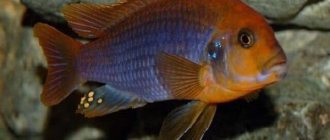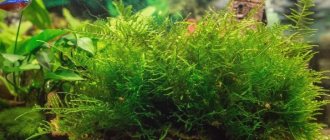To keep red-eared turtles at home, you need a properly equipped aquarium of adequate size. It would be more accurate to call it an aquaterrarium, since such a reservoir contains not only a body of water, but also an island of land. You can buy housing for turtles in special. stores or do it yourself.
Since the reptile is quite demanding about its place of residence, you need to know how to properly set up an aquarium for a red-eared slider. Your pet's home should be as close as possible to its natural habitat. Only in this case will your ward be healthy and happy in his own way.
Aquarium volume for a red-eared turtle
You need to approach the choice of an aquarium based on the size of your red-eared pet or (if you have a young individual) take it right away “for growth.” Keep in mind. that in a few years a tiny turtle the size of a peach pit will turn into an adult the size of a saucer.
The optimal size of the aquarium depending on the size of the turtle:
- babies from 3 to 10 cm – 50 liters;
- young turtles from 10 to 16 cm - 80 liters;
- large turtles from 17 to 25 cm – 150 liters;
- adult animals – from 150 liters.
In order to prevent the red ear from escaping, the top of the aquaterrarium should be closed with a lid that allows air to pass through well.
Selection of capacity
Red-eared turtles are classified as aquatic species, so they need an aquatic environment to feel safe. To raise a reptile in captivity, you need a properly equipped aquaterrarium - an aquarium filled with water and containing an island of land so that the turtle can warm up and bask in the rays. When buying terrariums, you should select a container “for growth”, since turtles grow rapidly, and soon your pet will feel cramped in a small container.
You can choose a suitable aquarium for a red-eared slider based on the following data:
- For a small pet up to 10 cm in size, a container with a capacity of 50 liters is suitable.
- Young representatives up to 16 cm will feel comfortable in a reservoir of 80 liters.
- An aquarium for red-eared turtles with a volume of 150 liters is needed for those pets whose size is up to 25 cm.
- Formed pets need a container with a capacity of 150 liters or more.
Article on the topic: Algae and soil for an aquarium with a red-eared turtle
When choosing aquariums, you should take into account that in a small container the aquatic environment becomes polluted more quickly, which leads to a deterioration in the condition of the turtles. In addition to its capacity, the turtle aquarium is equipped with a ventilated roof that fits tightly to the tank so that the pets cannot travel.
Temperature
The recommended water temperature for the red-eared turtle is 23-28 °C. The temperature on a shaded (cold) island of land should be 23-25°C, and on a brightly lit (warm) area - 28-32°C. This is an absolutely ideal option for arranging the most suitable temperature conditions for the red-eared turtle.
To create such temperature conditions, heating is necessary. The main heating is carried out using a special lamp, which is fixed above one of the islands. If the temperature when heating with a lamp is insufficient, then additional heating is used.
You can use a heater in the form of a long glass tube that is immersed in water. Particular attention should be paid to its location: the turtle should not be able to accidentally bite the electrical wire or damage it with its shell.
Filtration
The health of the turtle directly depends on the state of the water in the aquarium, so it must be kept clean. For a terrarium, it is better to use external aquarium filters of any type.
It is not advisable to install internal equipment, as it quickly becomes clogged with suspensions, losing efficiency.
The better the filter works, the less often a complete water change will be needed.
To maintain ecological balance, regular weekly replacement of half the volume of water is necessary. Before replacing, the water is allowed to settle.
Incandescent lamp
An ordinary incandescent lamp (an energy-saving lamp will not work) is installed above the island at such a distance that the air temperature above this area of land is 30-32 ° C. At night it is turned off.
UV lamp
Some owners of red-eared turtles neglect to install a UV lamp. However, this is a vital component of a reptile’s home. Its absence often leads to the development of diseases that can be fatal. Ultraviolet light is extremely important for the health of the red ear. It has a beneficial effect on metabolism, improves the condition of the reptile’s shell and skin, and helps the absorption of calcium. The UV lamp is placed at a height of at least 30 cm above the shore. It should burn for at least 2-3 hours a day.
Today you can purchase special lamps for terrariums with the required wavelength in almost any specialized store.
Ultraviolet lighting
The main principle of keeping turtles in captivity is to create a natural environment. In nature, turtles love to bask in the sun, so in an artificial pond you will need:
- An incandescent light bulb is placed over land to achieve a temperature of 23-28C. At night the lights are turned off.
- The most significant aspect in keeping red-eared turtles is considered to be ultraviolet lighting, with the help of which the reptiles absorb calcium, which is necessary for the strength of the shell. In terrariums, UV lamps must be installed at a distance of at least 30 cm from the soil. Daylight hours are 12 hours.
Note: Only UVB and UVA rays can be used.
Aquarium decoration
The main principle of choosing decorations is safety. Do not use items made from environmentally hazardous materials or with sharp corners or edges.
The soil for the bottom should not be very fine, as turtles can sometimes swallow it. Also, fine soil quickly becomes contaminated and is difficult to clean. It is better to use pebbles with a fraction of 5-6 cm.
For young turtles, you can plant green plants and introduce fish. Adults do not need soil, and they can eat or damage plants and fish.
In an aquarium with red-eared turtles, artificial plants made of plastic or silk would be appropriate. They are secured in the ground using weights. You can also install artificial vines on the islands.
To decorate the terrarium, you can use a variety of driftwood, grottoes, unusual stones and other elements. The driftwood should not be fresh, as it will release harmful substances into the water. It is better to take pieces of wood that have lain in the water of a body of water for a long time. The bark needs to be removed from them.
Filling the terrarium
In order for the turtle to feel good, not get sick and make all family members happy, it is necessary to create favorable living conditions for it. Let's decide how to fill the terrarium correctly.
The lid will protect the reptile from attacks by other inhabitants of the apartment - for example, cats. In addition, it is on the cover that you will mount the lamp, so the material for this part must be chosen carefully. Most often it is glass or metal.
If the conversation turns to lighting, then we can recommend a regular 60 W light bulb. It must be placed in such a way that it does not touch the walls, without creating overheating and a fire hazard. The corner that the lamp heats will be used by the turtle for eating, bathing and resting. The temperature in this place should not exceed 30°C, and in the rest of the terrarium - within 23-26°C. In the coldest and most shaded place, it is worth installing one or more shelters - a purchased or home-made house, a hollow driftwood, part of a clay pot, half a coconut.
It is worth installing an ultraviolet lamp. Keep in mind that the distance from the floor surface to the lighting fixtures must be at least 30 centimeters so that the turtle does not get burned.
One ventilation hole should be located at the top, for example on the side wall. You can make another one near the floor on the opposite wall. This will ensure the necessary flow of oxygen, stable air exchange, and elimination of unpleasant odors.
The soil is poured in a high layer, 3-5 centimeters. Small particles cannot be used as a coating - the reptile can swallow them. So put away sand, gravel chips, and small substrates. Sharp objects are also dangerous: expanded clay, gravel, shavings. Land turtles feel good in terrariums where the floor is covered with large sawdust, hay, and round pebbles. If the turtle does not like to burrow into the ground, then you can put paper or napkins.
Note!
There are aquariums in which red-eared sliders cannot be kept:
- Small turtle tanks with a volume of up to 50-70 liters. They can only be used for temporary housing of animals. If a turtle lives in such a container for a long time, then it develops skin infectious diseases, dystrophy and softening of the shell.
- Aquariums in which the land is made of plastic.
- Aquariums in which it is impossible to set the desired temperature, as well as ultraviolet light and filtration. The absence of all these conditions leads to illness and death of turtles.
Thus, caring for a red-eared slider, like any other pet, requires some effort. But a terrarium in which the water is clean, the bottom is picturesque, and the animals are healthy is a fascinating sight that is worth the time and effort.
The presenters of the Karusel TV channel will tell you how to properly equip a terrarium for a red-eared turtle:
Priming
For the red-eared birds themselves, the soil in their home is not particularly important or necessary. Another thing is that owners usually try to decorate their pet’s habitat. Of course, the aquaterrarium should look aesthetically pleasing. But do not forget that not all materials are suitable for this purpose.
Large stones without sharp edges or pebbles at least 5 cm in size are suitable as soil. The reptile can swallow small pebbles, which will lead to serious health problems, and the sharp edges can injure the reptile.
In principle, it is not forbidden to use sand as soil. The only “but” is that cleaning an aquaterrarium with sand is not very convenient.
Large shells will not only decorate your pet’s home, but will also saturate the water with calcium.
It is prohibited to use various plastic and glass pebbles for aquariums.
Plants in an aquaterrarium
There is no point in planting plants in the red-eared home. Without thinking twice, your pet will eat them or dig them up. You can try decorating the aquarium with commercially available artificial plants, securely fastening them to the bottom. You can do without plants altogether by decorating the aquarium with various driftwood, unusual stones, etc. But keep in mind: you should only take driftwood that has been in the water for a long time. Fresh wood is not suitable.
An interestingly designed aquarium for red-eared turtles will add zest to any interior. But do not forget that when choosing decorations, first of all you need to think about the safety of your pet.
Reptile Neighborhood
The red-eared turtle lives on land and loves to live in the water. She is very demanding of her environment. Therefore, choose aquariums that match the size of the animal, as well as those with access from the water to land.
Do not move new household members into terrariums with seasoned reptiles. The animal experiences stress from a change in environment and therefore becomes aggressive. Create a quarantine for 2 months. Newborn turtles should be treated with care and should have a separate place to live. Pets of the same size live next to each other without harming each other.
The proximity of red-eared turtles to aquarium fish in the same aquarium is not allowed. Reptiles can harm or eat fish. The maximum that can be done is to block a glass wall with small holes between them.
How to equip an island?
The red-eared turtle leads a sedentary lifestyle, spending a lot of time not only in the water, but also on the shore, so the aquarium must be equipped with at least one, or preferably several, land areas per turtle (one in a shaded place, and the other in a brightly lit, warm place ). On land, the turtle receives oxygen and enjoys UV rays.
What is important to consider?
- The land area should occupy at least a quarter of the entire bottom area.
- Land areas should have a sloping shore that smoothly rises from the bottom. Steep cliffs are not allowed. You can build a ladder or a mini-ladder, put a large stone or a grotto with gentle walls.
- The surface of the islands must be made of high-quality materials and be rough. If there is soil on the island, it should not crumble into the water.
- If there are several turtles, then the land must have such a total area that all individuals simultaneously have access to it and can fit.
- If there are several islands, then some of them may not be completely dry, but covered with water by several millimeters.
The island should be located approximately 30 cm below the edge of the terrarium so that the animal does not get out and run away.
Conditions of detention
The decision to have an exotic pet requires the owner to take a serious approach and responsibility for the life of the small creature. For normal life, pets need the correct arrangement of an aquarium for a red-eared turtle. The following aspects play an important role in keeping reptiles:
- Island.
- Water environment.
- Water temperature.
- Ultraviolet light bulbs.
- Aquarium filter.
Before you set up an aquarium for your red-eared slider, you should find out how much water you need to pour into the container. As mentioned earlier, reptiles are aquatic animals that require an aquatic environment; it is in water that exotic pets feel protected and calm. In order for pets to swim without difficulty and feel comfortable, the water level in the aquarium should be at least 0.4 m. The liquid is replaced weekly, updating 30-40% of the volume. It should be noted that the replacement water is pre-settled so that harmful substances evaporate. If the terrarium for red-eared pets is equipped with a high-quality filter, the liquid is changed once every 1.5 weeks.
Red-eared turtles are sedentary pets who, in their free time from swimming, prefer to lie on an island to bask. The size of the dry area should be ¼ of the container's capacity. In addition to the dimensions, it is important to firmly fix the land so that the island does not wobble, can withstand the weight of the pet, and is stable. You can make an island in a terrarium for a red-eared turtle with your own hands by fixing the base and laying out a flat bank of stones.
How to equip land - rules and recommendations:
- The land area is designed with a smooth shore, which should gradually rise so that pets can easily climb onto the island.
- The island must be made from natural materials to avoid poisoning the aquatic environment. The surface of the island should be decorated with a rough material, otherwise the turtles will slide off. You can use a substrate as a covering; however, when choosing this option, you need to make sure that the soil does not fall to the bottom.
- If two or more pets live in an aquarium, the area of dry soil is increased so that the turtles can fit. In this case, you can make one island dry and illuminated, and the other wet and darkened.
- The area with dry land in a terrarium with turtles is located 30 cm below the edge of the container, otherwise the pets will run away.
Article on the topic: Caring for a turtle aquarium: cleaning and maintenance
Prohibited aquariums for turtles
The following aquariums should not be used for aquatic turtles:
Are you concerned about the health of your pet? We are responsible for those we have tamed!” - says a quote from the story “The Little Prince”. Maintaining the health of a pet is one of the main responsibilities of the owner. Take care of your pet by giving him the Vitatame . The unique complex is designed for cats and dogs, as well as birds and rodents. Vitatame active supplement will help your pet shine with health and share happiness with you!
- Having a volume of 50−70 liters. If a turtle lives in such a small space for a long time, then over time it develops infectious skin diseases, degeneration and softening of the shell.
- In which the sushi island is made of plastic.
- In which it is impossible to install lighting, ultraviolet lamps and filtration. Their absence leads to the death of turtles.
Thus, caring for a red-eared turtle is still not very easy. Only compliance with all conditions of proper maintenance makes the life of turtles long and happy.











